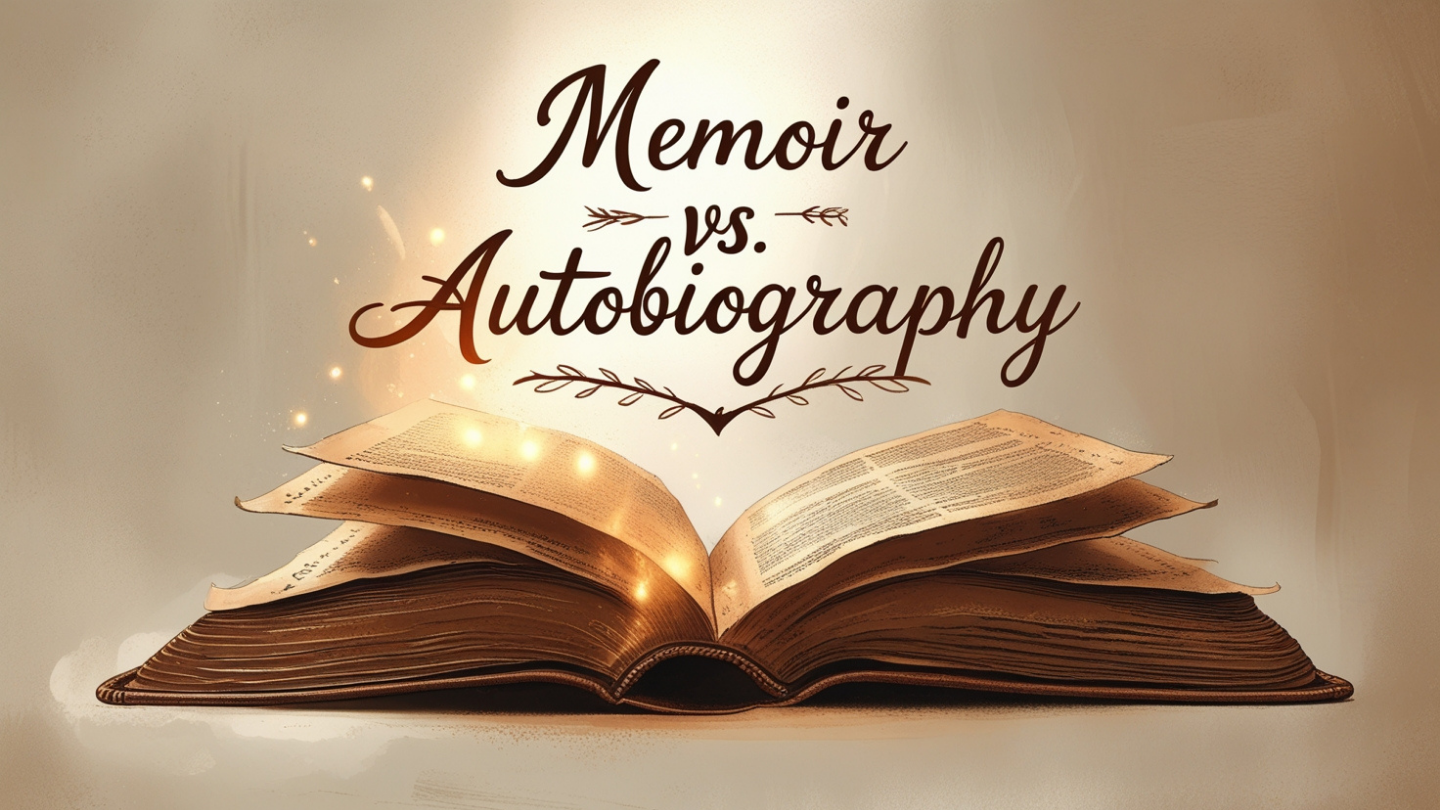Every writer of personal stories eventually faces this pivotal question: Should you explore a single transformative experience through a memoir or present your life’s full arc via autobiography? This choice fundamentally shapes how readers connect with your story.
Understanding This Distinction Helps You:
- Select the format that best serves your narrative purpose.
- Meet reader expectations for either emotional depth or factual completeness.
- Avoid blending approaches in ways that dilute your impact.
The Essential Autobiography and Memoir Difference:
Memoirs examine life through a microscope; autobiographies survey it from a telescope’s vantage point.
What is a Memoir?
A memoir illuminates a specific facet of life, a particular relationship, career phase, or personal transformation. What it sacrifices in breadth, it gains in emotional resonance.
Hallmarks Include:
- Focused Scope: Targets a defining period or theme (e.g., recovery from illness, a cross-cultural upbringing)
- Subjective Lens: Prioritizes personal truth over comprehensive fact
- Literary Craft: Employs narrative techniques like thematic organization and vivid scene-setting
Example: In Educated, Tara Westover concentrates on her journey from isolated childhood to scholarly achievement, leaving other life chapters untold.
What is an Autobiography?
An autobiography provides a complete chronological record, contextualizing personal milestones within historical moments.
Hallmarks Include:
- Life-Spanning Narrative: From early years to the present day.
- Objective Tone: Emphasizes verifiable events and dates.
- Historical Anchoring: Connects personal experiences to broader societal shifts.
Example: Nelson Mandela’s Long Walk to Freedom meticulously documents his life while chronicling South Africa’s anti-apartheid movement.
Core Distinctions at a Glance
- Purpose:
⮞ Memoir: Explores why an experience mattered (internal meaning)
⮞ Autobiography: Documents what occurred and when (external record) - Structural Approach:
⮞ Memoir: Thematic organization, often nonlinear
⮞ Autobiography: Chronological progression - Reader Experience:
⮞ Memoir: Creates emotional identification
⮞ Autobiography: Provides historical understanding
Why the Choice Matters
Your format decision influences:
- Reader Connection: Will audiences feel your journey or study it?
- Narrative Freedom: Do you need a creative license or factual rigor?
- Legacy Impact: Is your goal personal catharsis or historical documentation?
Consider The Glass Castle (memoir) versus The Autobiography of Benjamin Franklin – one immerses readers in emotional truth, and the other provides an authoritative life record.
Key Questions to Determine Your Format
Lean Toward Memoir If:
- Your story centers on a pivotal transformation or relationship.
- Emotional truth outweighs comprehensive detail.
- You want to employ literary devices and a subjective perspective.
Choose Autobiography When:
- Your life story intersects with significant historical events.
- Factual accuracy and completeness are priorities.
- You’re documenting professional achievements or public legacy.
Memoir vs. Autobiography: Key Differences
To clarify the autobiography and memoir difference, here’s a detailed comparison of their core distinctions:
| Aspect | What Is A Memoir |
What Is An Autobiography |
|
Scope |
Focuses on a specific theme, period, or relationship (e.g., “my years in the military”). | Covers the author’s entire life chronologically (e.g., “birth to present”). |
|
Purpose |
Explores emotional truth and personal growth. | Documents factual events and historical context. |
|
Structure |
Thematic or nonlinear; uses literary devices like flashbacks. | Linear timeline with clear dates/locations. |
|
Voice |
Intimate, subjective, and reflective. | Objective, authoritative, and detail-oriented. |
|
Audience |
Readers seeking relatable, transformative stories. | Researchers, historians, or fans want a complete life record. |
Difference Between Memoir and Autobiography in Practice
1. Memory vs. Fact
- Memoir: Prioritizes the author’s perspective (e.g., Joan Didion’s The Year of Magical Thinking on grief).
- Autobiography: Requires verifiable facts (e.g., Benjamin Franklin’s autobiography includes career milestones).
2. Emphasis
- Memoir: “How did this experience change me?”
- Autobiography: “What happened, and when?”
3. Publishing Expectations
- Memoirs often appeal to trade publishers for their narrative appeal.
- Autobiographies are common among public figures or niche academic presses.
Memoir vs. Autobiography Examples:
- Memoir: Wild by Cheryl Strayed (a transformative hike, not her whole life).
- Autobiography: I Know Why the Caged Bird Sings by Maya Angelou (childhood to adulthood).
Real-Life Examples: How Memoirs and Autobiographies Tell Unique Stories
To grasp the difference between memoir and autobiography, let’s dissect two iconic works:
Memoir Example 1: The Glass Castle by Jeannette Walls
- Focus: Walls narrows in on her chaotic childhood marked by poverty and her father’s idealism.
- Structure: Non-chronological vignettes (e.g., burning herself at age 3, dumpster diving as a teen).
- Emphasis: Emotional truth over strict factuality. Walls writes, “I was on fire not just my shirt, but my hair, my hands.”
- Why It’s a Memoir: Explores how her upbringing shaped her resilience, not every life event.
Autobiography Example 1: I Am Malala by Malala Yousafzai
- Focus: Chronicles Malala’s life from birth through her activism, shooting, and Nobel Prize.
- Structure: A linear timeline with dates, political context, and family history.
- Emphasis: Factual reporting (e.g., “On October 9, 2012, a Taliban gunman shot me.”).
- Why It’s an Autobiography: Prioritizes completeness education advocacy, cultural shifts, and global impact.
Memoir Example 2: Educated by Tara Westover
- Focus: Westover’s journey from an isolated, survivalist childhood to earning a PhD.
- Structure: Thematic arcs (family loyalty vs. self-liberation).
- Emphasis: Internal conflict, not exhaustive life details.
- Why Memoir: Centers on her relationship with education, skipping decades of her adult life.
Autobiography Example 2: The Autobiography of Benjamin Franklin
- Focus: Franklin’s life from childhood to statesmanship, including inventions and diplomacy.
- Structure: Chronological chapters with historical context (e.g., “In 1726, I established my first printing house”).
- Emphasis: Documenting achievements and societal contributions.
- Why Autobiography: Aims to inform, not introspect.
What These Examples Teach Us
Memoir: The Glass Castle by Jeannette Walls
⮞ Lesson: Memoirs thrive on raw emotion and thematic focus. Walls doesn’t catalog every childhood event, she zooms in on poverty, neglect, and resilience, letting readers connect through shared struggles.
⮞ Takeaway: Memoirs prioritize how an experience felt over every detail of what happened.
Memoir: Educated by Tara Westover
⮞ Lesson: Memoirs can span years but still focus on a single transformative arc. Westover skips mundane adulthood details to dissect her journey from isolation to education.
⮞ Takeaway: A memoir’s power lies in depth over breadth, zooming into moments that redefine identity.
Autobiography: I Am Malala by Malala Yousafzai
⮞ Lesson: Autobiographies educate through factual rigor. Malala blends personal milestones (e.g., her Nobel Prize) with Pakistan’s political history, appealing to readers seeking inspiration and context.
⮞ Takeaway: Autobiographies are archives they preserve what happened for posterity.
Autobiography: The Autobiography of Benjamin Franklin
⮞ Lesson: Autobiographies document legacy. Franklin chronicles inventions, diplomatic missions, and founding fatherhood with detached precision, aiming to inform rather than emote.
⮞ Takeaway: Autobiographies serve historians; memoirs serve the heart.
Why Format Choice Matters
These memoir vs. autobiography examples prove:
- Memoirs like Educated and The Glass Castle succeed through vulnerability and thematic resonance.
- Autobiographies like I Am Malala and Franklin’s work endure as historical records, not emotional journeys.
Key Takeaway
“These memoir and autobiography examples highlight why format choice impacts reader connection.”
Why It Matters:
Memoirs like Educated and The Glass Castle succeed by making readers ask, “Have I ever felt this way?” Autobiographies like I Am Malala and Franklin’s work prompt questions like, “How did this shape the world?”
Your format choice isn’t just about structure it’s about who you want your readers to become after closing the book.
How to Choose: Memoir or Autobiography?
Deciding ‘memoir vs. autobiography’ starts with asking: “Whose story am I really telling?” If it’s yours through a narrow lens, lean memoir. If it’s yours as part of history, choose autobiography.
Pick Memoir If:
1. You’re exploring one transformative experience (e.g., addiction, caregiving, immigrating).
Example: Joan Didion’s The Year of Magical Thinking dissects grief after her husband’s death not her whole life.
2. You want creative freedom with metaphors, nonlinear timelines, or poetic license.
Example: Wild by Cheryl Strayed uses her Pacific Crest Trail hike to reflect on loss.
3. You’re writing about identity (e.g., race, sexuality, faith) through personal milestones.
Example: Hunger by Roxane Gay focuses on her relationship with body image.
4. You want to spotlight relationships (family, mentors, friendships) rather than chronology.
Example: The Liars’ Club by Mary Karr centers on her chaotic upbringing in Texas.
Pick Autobiography If:
1. You’re a public figure documenting historical events (e.g., political career, scientific breakthroughs).
Example: A Promised Land by Barack Obama details his presidency’s pivotal moments.
2. You prioritize factual accuracy over lyrical prose (e.g., dates, names, verified events).
Example: Long Walk to Freedom by Nelson Mandela meticulously records his anti-apartheid activism.
3. You’re correcting public narratives about your life or career.
Example: Open by Andre Agassi rebuts media myths about his tennis career.
4. You want to contextualize your legacy within broader history.
Example: The Autobiography of Malcolm X ties his personal journey to the Civil Rights movement.
Still stuck? Write three paragraphs about your life, one memoir-style (focused on a single event) and one autobiography-style (timeline of achievements). Which feels truer?
Writing Tips: How Memoir and Autobiography Differ in Writing
Memoir Writing Tips
1. Start with Vignettes, Not Timelines
Forget chronology. Begin with vivid snapshots the smell of your grandmother’s kitchen, a fight with a sibling, the moment you quit your job. The Glass Castle works because Walls builds her memoir around fragmented, sensory-rich memories rather than a strict timeline.
2. Sensory Details Are Your Secret Weapon
Make readers feel your story:
“The campfire smoke clung to my hair for days” (tactile/smell).
“His laugh was a chainsaw ripping through silence” (metaphor + sound).
3. Dialogue Brings Scenes to Life
Recreate conversations, even if paraphrased. In Educated, Westover uses dialogue to expose her family’s contradictions:
“Mom said we’d learn more from nature than school. Dad said schools were government traps.”
4. Thematic Arcs Over Plots
Link memories to a central question. If your theme is resilience, show how childhood struggles shaped adult choices.
Pro Tip: Write your first draft like a diary raw and messy. Structure comes later.
Autobiography Writing Tips
1. Research Like a Historian
Verify dates, names, and events. Malala’s I Am Malala cites exact speeches, political events, and cultural shifts.
2. Chronology Is Your Backbone
Organize chapters by era:
• Early Life → Career Beginnings → Major Achievements
Benjamin Franklin’s autobiography follows this structure, making his complex life digestible.
3. Balance Facts with Readability
Avoid dry lists. Use anecdotes to humanize milestones. For example, instead of “I became CEO in 2010,” write:
“The board voted me CEO on a rainy Tuesday—the same day my daughter took her first steps.”
4. Address Legacy and Impact
Explain how your life intersected with broader history. Mandela’s Long Walk to Freedom ties personal sacrifices to South Africa’s anti-apartheid movement.
Pro Tip: Create a timeline spreadsheet before drafting. Color-code personal vs. historical events.
Final Words
Memoirs zoom in capturing life’s defining moments with raw intimacy. Autobiographies zoom out chronicling the full arc of life against the backdrop of history. Your choice isn’t just about structure; it’s about how you want readers to experience your truth. A memoir makes them feel your journey; an autobiography invites them to witness it.
The best stories aren’t just told they’re strategically shaped. Whether you’re dissecting a transformative chapter or documenting a legacy, the right format ensures your voice isn’t just heard but remembered.
Let’s Build Your Story’s Blueprint
Stuck between the depth of a memoir and the breadth of an autobiography? Arkham House Publishers’ editors specialize in helping writers like you:
- Clarify your narrative vision (What’s the heart of your story?).
- Choose the format that amplifies your impact.
- Structure your truth with confidence, no more guesswork.
Your story deserves the right frame. Schedule your consult today and start strong.





